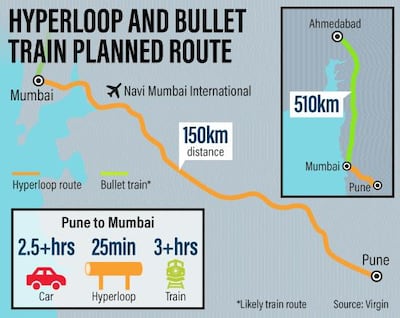It is a radical design concept that the UAE has embraced with energy and conviction – an ultra-high speed transport system that could shuttle passengers between Abu Dhabi and Dubai in 12 minutes.
The Hyperloop would reach speeds of up to 1,200 kilometres per hour by using electromagnets to propel trains through a low-pressure tube.
It is a concept billionaire entrepreneur Elon Musk came up with in 2013 and it promises to revolutionise transport as we know it.
The Hyperloop is so promising that it is attracting the attention of other countries, and India might just beat the Gulf to it.
“With growing mobility across cities in India there is a need to explore all types of transport solutions,” said Satish Modh, director of the VES Institute of Management Studies and Research in Mumbai.
“India needs a revolutionary innovation to cater to its large population and the high-speed Hyperloop may be one. It has all the benefits of speed, low power consumption, low cost in the long run and technology which is immune to bad weather.”
Plans to launch the system are gathering pace in India, where the authorities hope to drastically cut journey times and ease pressure on over-burdened railway networks.
Under the proposed project, a line will be built between the Indian financial capital of Mumbai and Pune, the second largest city in the state of Maharashtra.
Once up and running, engineers expect the 150-kilometre trip, which now takes about three hours by road or train, will be cut to 25 minutes.
Virgin Hyperloop One, a company in California, is one of several vying to be the first to build the Hyperloop in the UAE and India.
Meanwhile, Hyperloop Transportation Technologies, another company in California, is also in the running to build a Hyperloop for India.
It signed an agreement with the state of Andhra Pradesh in south-eastern India last September and is looking at the project’s feasibility.
India, which has a population of more than 1.3 billion, has a dilapidated transport network and there are many train accidents. The government is well aware of the problems but many of the roads are in a terrible condition and the country needs new trains.
Cities such as Mumbai also struggle with an expanding population. Meanwhile, urban centres like Pune are quickly becoming major cities in their own right.
________________
Read more:
Work begins on Hyperloop passenger tubes
DP World-backed Virgin Hyperloop One to build rapid-transit route in India
Dubai to Abu Dhabi commute in 15 minutes? Time to believe the hype
_________________
Official figures show the country’s 110,000km of track carry more than 23 million passengers and three million tonnes of freight a day.
But old locomotives and extensive overcrowding create safety problems, with thousands of railway-related deaths recorded each year.
Virgin Hyperloop One says its Pune-to-Mumbai line could bring in about $55 billion (Dh202bn) in economic benefits, including cuts in travel times, emissions and accidents over 30 years.
The company, which has almost completed a feasibility study into a short demonstration track, said its scheme could cut greenhouse gas emissions by up to 150,000 tonnes a year.
But some analysts argue that Hyperloop is too much of a risk for India. Chandramouli Nilakantan, chief executive of TRA Research, a Mumbai brand consultancy, said the country needed to focus on improving existing infrastructure before gambling on unproven technology.
“Hyperloop is a fresh technology and it’s almost like using India as a guinea pig,” Mr Nilakantan said. “In a crowded economy where transport needs are a lifeline, there isn’t scope for testing things out.
“You can do this in a country where the regular transport system is already robust.”
India is working on other solutions to solve its transport needs, including bullet trains.
Prime Minister Narendra Modi announced the country’s first bullet train project during the visit of Japanese leader Shinzo Abe to the state of Gujarat in western India last year.
The $17bn high-speed train is planned to travel the 510km between Ahmedabad, a commercial centre in Gujarat, and Mumbai.
But the scheme, with an expected completion date of 2022, has already experienced challenges, including local opposition and obstacles in securing the land needed.
If the Hyperloop project does come to fruition between Pune and Mumbai, Dubai ports operator DP World, which has heavily invested in Virgin Hyperloop One, says it could revolutionise the movement of cargo. The company said about a quarter of cargo handled at India’s largest port, Jawaharlal Nehru, located just outside of Mumbai, comes from or is sent to Pune.
“A large portion of this cargo is transported by road along the crowded Mumbai-Pune corridor,” DP World said. “The Hyperloop system will deliver freight at the speed of flight, which will support Pune’s growing manufacturing.
“It will alleviate severe congestion along the corridor, facilitate on-demand shipments and create a backbone for efficient supply chains.”
But despite the optimism for the project among some, experts recognise there is a long way to go for the Hyperloop in India and the UAE. No time frame appears to have been set, and feasibility studies continue.
“Before making large investments we need to consider issues of passenger discomfort, risk of accidents and the cost of installation and maintenance,” Mr Modi said.


